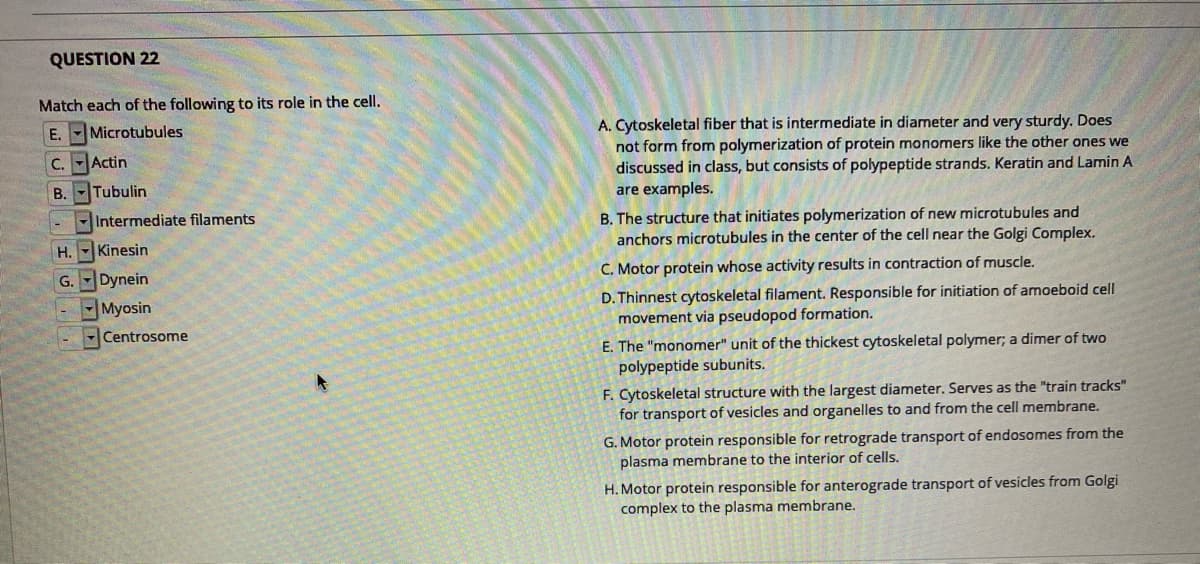QUESTION 22 Match each of the following to its role in the cell. A. Cytoskeletal fiber that is intermediate in diameter and very sturdy. Does not form from polymerization of protein monomers like the other ones we discussed in class, but consists of polypeptide strands. Keratin and Lamin A are examples. E. Microtubules C.Actin Tubulin B. B. The structure that initiates polymerization of new microtubules and anchors microtubules in the center of the cell near the Golgi Complex. Intermediate filaments H. -Kinesin C. Motor protein whose activity results in contraction of muscle. G. Dynein D. Thinnest cytoskeletal filament. Responsible for initiation of amoeboid cell movement via pseudopod formation. Myosin Centrosome E. The "monomer" unit of the thickest cytoskeletal polymer; a dimer of two polypeptide subunits. F. Cytoskeletal structure with the largest diameter. Serves as the "train tracks" for transport of vesicles and organelles to and from the cell membrane. G. Motor protein responsible for retrograde transport of endosomes from the plasma membrane to the interior of cells. H. Motor protein responsible for anterograde transport of vesicles from Golgi complex to the plasma membrane.
QUESTION 22 Match each of the following to its role in the cell. A. Cytoskeletal fiber that is intermediate in diameter and very sturdy. Does not form from polymerization of protein monomers like the other ones we discussed in class, but consists of polypeptide strands. Keratin and Lamin A are examples. E. Microtubules C.Actin Tubulin B. B. The structure that initiates polymerization of new microtubules and anchors microtubules in the center of the cell near the Golgi Complex. Intermediate filaments H. -Kinesin C. Motor protein whose activity results in contraction of muscle. G. Dynein D. Thinnest cytoskeletal filament. Responsible for initiation of amoeboid cell movement via pseudopod formation. Myosin Centrosome E. The "monomer" unit of the thickest cytoskeletal polymer; a dimer of two polypeptide subunits. F. Cytoskeletal structure with the largest diameter. Serves as the "train tracks" for transport of vesicles and organelles to and from the cell membrane. G. Motor protein responsible for retrograde transport of endosomes from the plasma membrane to the interior of cells. H. Motor protein responsible for anterograde transport of vesicles from Golgi complex to the plasma membrane.
Human Anatomy & Physiology (11th Edition)
11th Edition
ISBN:9780134580999
Author:Elaine N. Marieb, Katja N. Hoehn
Publisher:Elaine N. Marieb, Katja N. Hoehn
Chapter1: The Human Body: An Orientation
Section: Chapter Questions
Problem 1RQ: The correct sequence of levels forming the structural hierarchy is A. (a) organ, organ system,...
Related questions
Question

Transcribed Image Text:QUESTION 22
Match each of the following to its role in the cell.
A. Cytoskeletal fiber that is intermediate in diameter and very sturdy. Does
not form from polymerization of protein monomers like the other ones we
discussed in class, but consists of polypeptide strands. Keratin and Lamin A
are examples.
E.Microtubules
C.
Actin
B.
Tubulin
B. The structure that initiates polymerization of new microtubules and
anchors microtubules in the center of the cell near the Golgi Complex.
Intermediate filaments
H. Kinesin
C. Motor protein whose activity results in contraction of muscle.
Dynein
Myosin
G.
D. Thinnest cytoskeletal filament. Responsible for initiation of amoeboid cell
movement via pseudopod formation.
-Centrosome
E. The "monomer" unit of the thickest cytoskeletal polymer; a dimer of two
polypeptide subunits.
F. Cytoskeletal structure with the largest diameter. Serves as the "train tracks"
for transport of vesicles and organelles to and from the cell membrane.
G. Motor protein responsible for retrograde transport of endosomes from the
plasma membrane to the interior of cells.
H. Motor protein responsible for anterograde transport of vesicles from Golgi
complex to the plasma membrane.
Expert Solution
This question has been solved!
Explore an expertly crafted, step-by-step solution for a thorough understanding of key concepts.
This is a popular solution!
Trending now
This is a popular solution!
Step by step
Solved in 4 steps

Knowledge Booster
Learn more about
Need a deep-dive on the concept behind this application? Look no further. Learn more about this topic, biology and related others by exploring similar questions and additional content below.Recommended textbooks for you

Human Anatomy & Physiology (11th Edition)
Biology
ISBN:
9780134580999
Author:
Elaine N. Marieb, Katja N. Hoehn
Publisher:
PEARSON

Biology 2e
Biology
ISBN:
9781947172517
Author:
Matthew Douglas, Jung Choi, Mary Ann Clark
Publisher:
OpenStax

Anatomy & Physiology
Biology
ISBN:
9781259398629
Author:
McKinley, Michael P., O'loughlin, Valerie Dean, Bidle, Theresa Stouter
Publisher:
Mcgraw Hill Education,

Human Anatomy & Physiology (11th Edition)
Biology
ISBN:
9780134580999
Author:
Elaine N. Marieb, Katja N. Hoehn
Publisher:
PEARSON

Biology 2e
Biology
ISBN:
9781947172517
Author:
Matthew Douglas, Jung Choi, Mary Ann Clark
Publisher:
OpenStax

Anatomy & Physiology
Biology
ISBN:
9781259398629
Author:
McKinley, Michael P., O'loughlin, Valerie Dean, Bidle, Theresa Stouter
Publisher:
Mcgraw Hill Education,

Molecular Biology of the Cell (Sixth Edition)
Biology
ISBN:
9780815344322
Author:
Bruce Alberts, Alexander D. Johnson, Julian Lewis, David Morgan, Martin Raff, Keith Roberts, Peter Walter
Publisher:
W. W. Norton & Company

Laboratory Manual For Human Anatomy & Physiology
Biology
ISBN:
9781260159363
Author:
Martin, Terry R., Prentice-craver, Cynthia
Publisher:
McGraw-Hill Publishing Co.

Inquiry Into Life (16th Edition)
Biology
ISBN:
9781260231700
Author:
Sylvia S. Mader, Michael Windelspecht
Publisher:
McGraw Hill Education